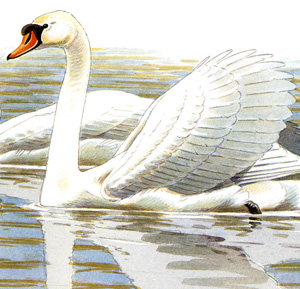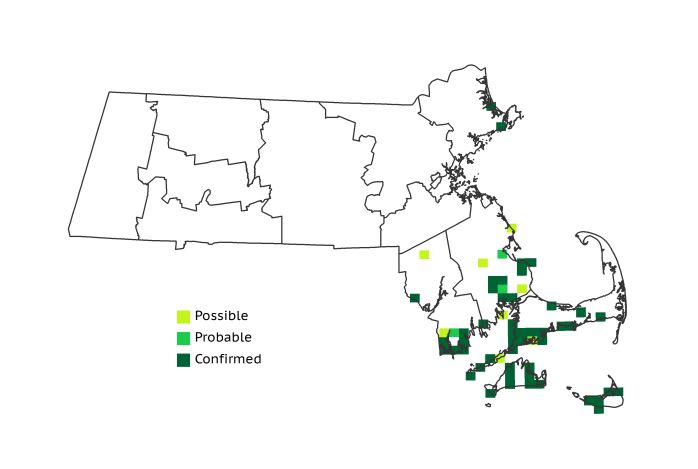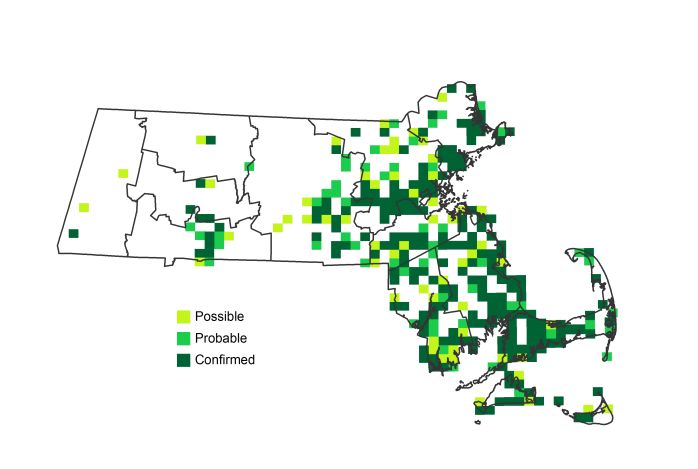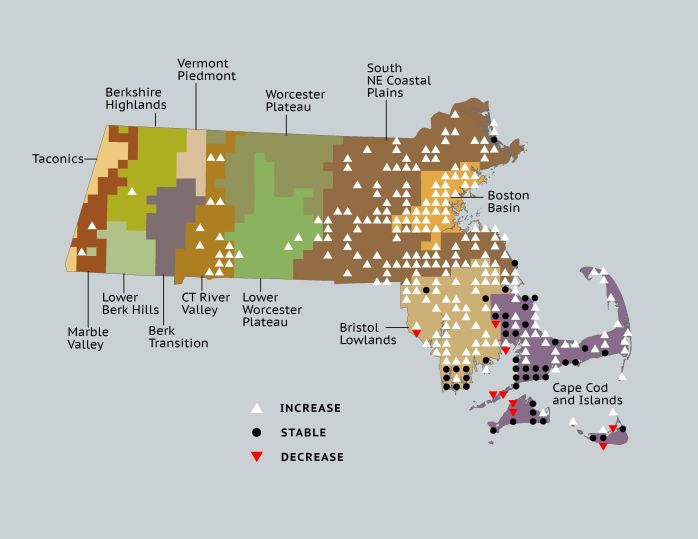Breeding Bird Atlases (BBA)
Find a Bird
Mute Swan
Cygnus olor

Somewhat local and strongly increasing
“Beauty isn’t the point here; / of course the swan is beautiful,” – Ruth L. Schwartz, “The Swan at Edgewater Park”
The Mute Swan seems to radiate elegance, from its snowy white plumage to its S-curved neck and its gracefully arched wings. It was precisely this degree of aesthetic appeal that inspired Americans to import these birds from Europe as ornamental park birds near the turn of the twentieth century. The species found America much to its liking, and quickly established itself as a wild breeding bird on the northeast Atlantic coast as well as around the Great Lakes. In Massachusetts, Mute Swans are most prevalent in the southeast, although these large and aggressive waterfowl are presently in the process of expanding their range in the state.
Historic Status
The Mute Swan arrived in the United States as a boutique item during the Victorian Age, something nice to look at during the great era of exhibitionism in the northeastern United States. The population we have now probably descends from birds initially introduced on, and ultimately escaped from, Long Island and Hudson Valley estates around the beginning of the twentieth century. Irregular breeding by the 1960s gave way to more consistent nesting activity by the time of the first Massachusetts Breeding Bird Atlas.
Atlas 1 Distribution
As an expanding species from coastal areas south of Massachusetts, Mute Swans were predictably most heavily concentrated in southeastern Massachusetts during Atlas 1. A pair of blocks in Essex County and a Possible block in Plymouth were the only records of Mute Swan presence in the Coastal Plains, but there were more than a dozen reported locations for Mute Swan breeding in the Bristol/Narragansett Lowlands. The birds had fully established themselves on the Cape and Islands, which accounted for nearly 70% of all Atlas 1 records.
Atlas 2 Distribution and Change
The march of Mute Swans continued across the state during the inter-Atlas period, with Atlas 2 posting sightings in more than 30% of all the blocks in the state compared with only 6% during Atlas 1. Many of the western regions remain swan free, although the Connecticut River offers an avenue of colonization into the west. The pattern of settlement in the east shows persistence in block occupancy in much of the southeast, along with a filling in of their range in the Cape and Islands and the Bristol Lowlands. In this, the heart of their Massachusetts range, there are very few blocks reporting a loss of this species since Atlas 1. If left unchecked, Mute Swans will likely slowly continue their conquest of Massachusetts.
Atlas 1 Map

Atlas 2 Map

Atlas Change Map

Ecoregion Data
Atlas 1 | Atlas 2 | Change | ||||||
Ecoregion | # Blocks | % Blocks | % of Range | # Blocks | % Blocks | % of Range | Change in # Blocks | Change in % Blocks |
Taconic Mountains | 0 | 0.0 | 0.0 | 0 | 0.0 | 0.0 | 0 | 0.0 |
Marble Valleys/Housatonic Valley | 0 | 0.0 | 0.0 | 2 | 5.1 | 0.6 | 2 | 5.1 |
Berkshire Highlands | 0 | 0.0 | 0.0 | 1 | 1.8 | 0.3 | 1 | 1.9 |
Lower Berkshire Hills | 0 | 0.0 | 0.0 | 0 | 0.0 | 0.0 | 0 | 0.0 |
Vermont Piedmont | 0 | 0.0 | 0.0 | 0 | 0.0 | 0.0 | 0 | 0.0 |
Berkshire Transition | 0 | 0.0 | 0.0 | 0 | 0.0 | 0.0 | 0 | 0.0 |
Connecticut River Valley | 0 | 0.0 | 0.0 | 18 | 27.7 | 5.7 | 14 | 29.2 |
Worcester Plateau | 0 | 0.0 | 0.0 | 1 | 1.1 | 0.3 | 1 | 2.1 |
Lower Worcester Plateau | 0 | 0.0 | 0.0 | 5 | 6.3 | 1.6 | 4 | 7.4 |
S. New England Coastal Plains and Hills | 3 | 1.1 | 5.1 | 111 | 39.2 | 35.1 | 91 | 40.3 |
Boston Basin | 0 | 0.0 | 0.0 | 31 | 55.4 | 9.8 | 31 | 56.4 |
Bristol and Narragansett Lowlands | 15 | 14.2 | 25.4 | 64 | 56.1 | 20.3 | 43 | 42.6 |
Cape Cod and Islands | 41 | 30.1 | 69.5 | 83 | 57.6 | 26.3 | 31 | 25.8 |
Statewide Total | 59 | 6.1 | 100.0 | 316 | 30.5 | 100.0 | 218 | 26.3 |



